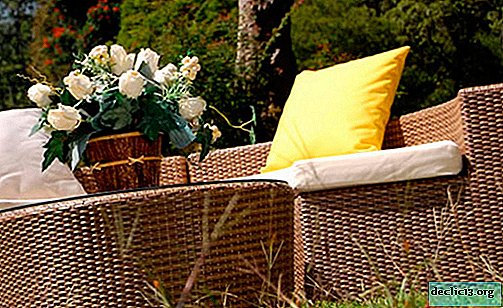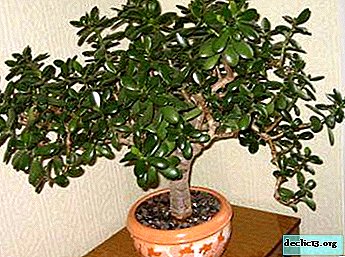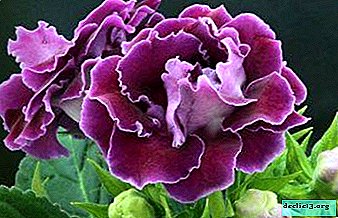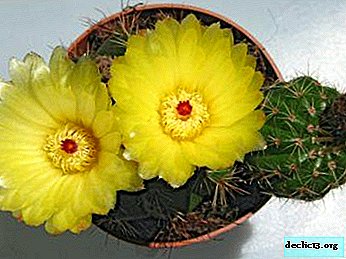How does fertilizer for orchids affect their appearance and growth?
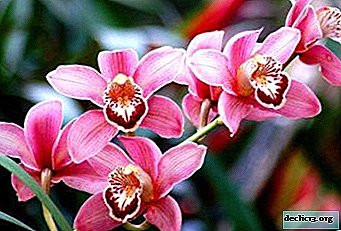 When cultivated, orchids are planted in a finished substrate from pine bark, which does not contain nutrients, but serves only as a support for the roots of the plant and as the basis for the mushrooms and saprophytes that feed the flower.
When cultivated, orchids are planted in a finished substrate from pine bark, which does not contain nutrients, but serves only as a support for the roots of the plant and as the basis for the mushrooms and saprophytes that feed the flower.
Gradually, useful substances are pulled out by the roots and washed out of the substrate, so the orchid must be fed, otherwise it can die without nutrients. Let's look at all the features of fertilizing.
What is more correct to feed?
It is better to feed the orchid with mineral fertilizers. Organic fertilizers are not so important for the plant, it can do without them perfectly.
You need to feed the orchid with complex fertilizers, which include nitrogen, potassium and phosphorus. It is these chemicals that stimulate the emergence of new buds and provide the appearance of beautiful and healthy flowers.What chemicals are needed to grow?
The orchid feed must contain the same chemicals that gardeners use to feed other indoor plants. But there is one limitation: it is necessary to change the proportions, quantity and composition of fertilizers, depending on the phase of flower development.
Let's consider how the absence or excess of a certain chemical substance affects a plant:
| Chemical element | Item lack | Oversupply item | How does it affect a plant? |
| Nitrogen | The plant slows growth, the leaves become small | The plant grows quickly, but does not bloom for a long time | Leaf development and growth |
| Phosphorus | Growth slows down, leaves begin to fade, spots appear on them | Leaves turn yellow, the plant degrades, grows old quickly, reacts to a lack of water | Peduncles form |
| Potassium | The plant does not bloom for a long time, the leaves turn yellow from the edges and fall off | Plant growth is delayed, the leaves grow small. May darken | Increases immunity, forms peduncles, helps long flowering |
| Magnesium | Pale leaves, color unsaturated, faded, flower grows slowly, does not bloom | Leaves darken, curl and die | Basis for plant participation in photosynthesis |
| Iron | Leaves turn yellow between veins | Leaves darken and stop growing | The basis for photosynthesis and metabolism |
| Calcium | Roots and stems grow weakly, the top dies, young leaves grow poorly and twist | Pale spots appear on the leaves, plant tissue dies | Participates in the metabolism, forms a strong stem and roots |
| Copper | The plant is sluggish, white spots appear on the leaves, the plant is sick with fungal and bacterial diseases | The flower grows slowly, brown spots appear on young leaves, old leaves are actively dying | Responsible for the overall strength of the plant, maintaining the immune system against various diseases |
 For orchids special complex fertilizers are usedthat are sold in flower shops. Usually in these fertilizers there are already 3 substances necessary for the plant: nitrogen, phosphorus and potassium.
For orchids special complex fertilizers are usedthat are sold in flower shops. Usually in these fertilizers there are already 3 substances necessary for the plant: nitrogen, phosphorus and potassium.
The proportional ratio of this triad (NPK) must be indicated on all packages of complex fertilizers for orchids.
- If you need to increase the green mass of the plant, then choose a ratio of 4: 3: 3.
- To stimulate flowering - 4: 6: 6.
It is necessary to have all kinds of complex dressings in stock. But remember that excess fertilizer is detrimental to the plant, and when hovering the solution, follow the instructions.
The list of effective mineral mixtures and their composition
Fertilizers for orchids:
- Fertica Crystal. A complex of phosphorus, potash, nitrogen water-soluble elements. It is introduced as top dressing after insufficient watering during the growing season. Fertilizer is bred 0.5 grams per 10 liters of water.
- Radifarm. Complex fertilizer, which includes polysaccharides, amino acids, vitamins, iron, zinc, is used for foliar application.
- Osmokot. Phosphorus-potassium-nitrogen fertilizer in the form of balls coated with biodegradable resin. It is very slowly removed from the plant. The action is the same as that of Fertik's crystal.
- Superphosphate. It is necessary to feed the plant with a solution of superphosphate when the period of rest of the flower ends.
- Sugar. Used to feed weakened plants. You need to feed in small doses: 1 teaspoon per 1 liter of water 1 time in 7 days in a superficial way. This dressing can be carried out only on the roots of the flower.
- succinic acid. It is a white powder and is sold in any pharmacy as a cheap food supplement. It affects the energy metabolism of the cell, forms cellular immunity, stimulates metabolic processes, activates flowering, enhances growth, resuscitates the plant, and neutralizes toxic substances.
Safe and non-toxic top dressing is used as an aqueous solution that can be stored for 2 weeks. You can apply dressing on all parts of the flower. For root dressing, dissolve 1 tablet in 500 ml of water and immerse the container with orchid in this solution from several minutes to several challah. Repeat the procedure once every 2 weeks.
All parts of the plant can be sprayed with a solution of the same concentration, only warm. Observe concentration, otherwise it can harm the plant.
- Bona forte - a concentrate for feeding orchids, which includes nitrogen, phosphorus, potassium, magnesium, a complex of vitamins C and B (they affect the ability to adapt to adverse conditions), a growth regulator (prevents aging), a fungicide and a bio-insecticide (they provide a safe life activity).
It is made in various ways in accordance with the instructions. But before applying dressing, you need to moisten the plant, otherwise the orchid will get burns. Concentration for root dressing - 5 ml per 1.5 liters of water; for foliar top dressing - 5 ml in 3 liters of water.
DIY Organic Solutions
The best fertilizers for orchids at home:
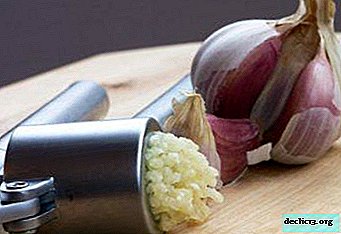 Garlic water. Garlic is very rich in vitamins, macro- and microelements, organic acids, sulfur, zinc, antioxidants, which are well absorbed and are an effective top dressing and natural insecticide and fungicide.
Garlic water. Garlic is very rich in vitamins, macro- and microelements, organic acids, sulfur, zinc, antioxidants, which are well absorbed and are an effective top dressing and natural insecticide and fungicide.The solution is easy to prepare:
- 1 liter of water (34-36 degrees) will require a slurry of 1 clove of garlic squeezed through a press;
- insist the solution for 40 minutes, strain and apply as a root and extra root treatment.
- Horse dung dissolve in water and water the roots. You can also use dry manure during transplantation, distributing it between parts of the substrate and on the surface in small quantities.
- Dried Banana Peels you need to cut and soak with warm water for several days. Then, with filtered solution, conduct root dressing. Useful for stimulating flowering.
Types of feeding
Root
This type of dressing can only be used for healthy plants:
- Before the procedure, you need to moisten the roots well.
- Dilute the fertilizer in water at room temperature in accordance with the proportions indicated in the instructions.
- A container with a flower should be slowly placed in a basin with a solution (so that the liquid does not push the plant out of their pot), water the orchid on top, trying not to get into the sinuses of the leaves and buds, and then leave it in the basin for 20-25 minutes for further nutrition.
- After the specified time, remove the flowerpot from the pelvis, drain the remaining solution.
This procedure is best done in the morning, when the ability to absorb nutrients from the roots of orchids is higher.
Outdoor
This type of dressing should be carried out in the case when the root system is sick or damaged. This dressing should not be carried out with direct sunlight, as this can lead to burns. It is best to feed a plant from a spray bottle in the evening or in cloudy weather.
You need to spray both sides of each leaf and the visible part of the roots. Leaf dressing is indispensable for chlorosis - lack of nutrients. With foliar feeding, food very quickly enters the leaves, and the effect is already visible after a few hours.
It is forbidden to spray flowers. If drops of solution fall on the buds, you need to dry them with a dry soft cloth.When and how to fertilize?
Do I need after the purchase?
 Top dressing a flower right after you brought it from the store is prohibited, because the plant is very used to the place and experiencing stress in the new room.
Top dressing a flower right after you brought it from the store is prohibited, because the plant is very used to the place and experiencing stress in the new room.
Even a minimal amount of fertilizer can lead to wilting and death of the plant. Usually a blooming orchid is sold in the store. Therefore, be sure to wait until the end of flowering and then feed.
It often happens that due to the accumulated nutrients, repeated flowering from sleeping buds develops. In this case, be sure to feed the plant 3-4 months after purchase, without waiting for the end of flowering.
Period of active growth
During the period of active growth, the orchid needs to be fed 2 times a monthto actively accumulate nutrients in the flower. The priority should be fertilizer, which contains nitrogen, which is responsible for the growth of the vegetative mass.
2 months before flowering, when the plant begins to lay peduncles and buds, you need to stop feeding with nitrogen and introduce more phosphorus and potassium supplements to the flower, which provide carbohydrate and protein metabolism of the flower, promote breathing, and affect lush flowering.
Can flowers be stimulated?
Yes, for the appearance of arrows and the formation of buds, you can use fertilizers such as:
- Bud;
- Ovary;
- Pollen.
Their use will make the orchid blossom ahead of schedule, even provoke re-bloom.
This is very dangerous for the plant, because it will lead to its depletion and ultimately to death.Read more about fertilizers for orchid flowering here.
Frequency before and during flowering
During this period, it is necessary to minimize the amount of nitrogen-containing fertilizers, as they inhibit the development of buds in flowers.
Effective during this period are complex fertilizers called Effect, Bon Forte, Flora, which can increase the flowering time up to six months. The amount of fertilizing should be reduced to 1 per week.
Read about how to fertilize an orchid during flowering in this article.
After wilting buds
After flowering, the orchid begins a dormant period (when the last bud withers). A weakened plant needs to be restored. To do this, you need to introduce additional dressing containing the necessary trace elements and nutrients in the first week after flowering.
For orchid regeneration it is necessary to use phosphorus and nitrogen fertilizers:
- Suite
- Rosop;
- Mr. color.
After transplant
 The optimal time for a plant transplant is considered to be a dormant period. After transplanting, you can’t feed, because the plant is under stress. Fertilizing should be started 3-4 weeks after transplantation, when the growth process becomes noticeable.
The optimal time for a plant transplant is considered to be a dormant period. After transplanting, you can’t feed, because the plant is under stress. Fertilizing should be started 3-4 weeks after transplantation, when the growth process becomes noticeable.
For top dressing, you need to use fertilizers that promote cellular recovery and stimulate plant growth. These are fertilizers Kornevin and Elin. Effectively during this period, nutrition with a solution of succinic acid.
Step-by-step instruction
Algorithm:
- Water the flower.
- Half an hour later, immerse the container with the flower in a solution with top dressing, or pour the solution several times, collecting it in a pan, or spray.
- Leave the flower to dry.
Exist general rules for feeding this plant, performing which you can conduct high-quality top dressing:
- Orchid needs to be fed all year round. In winter, top dressing is carried out once a month, in summer and spring - once every 2 weeks.
- The composition of the fertilizer for feeding the plant must necessarily vary depending on the phase of development of the flower.
- For orchids, you can use the same fertilizers as for the usual indoor plants. But it is better to use specialized fertilizers.
- Orchids are fed only with liquid fertilizers, by watering or spraying.
- You can not use fertilizers in the form of tablets and sticks and allow that, when feeding, the remains of fertilizer or sediment fall on the roots of the flower or leaves.
- You need to feed the orchid with a watering field, every second watering.
- You can not feed the orchid during and immediately after transplantation!
- Fertilizing is applied only during the growing season (the period of the highest activity of the plant, when there is active growth after a cold and "dark" winter, when the plant is preparing for flowering). It is better to fertilize before half opening the buds.
- During the active flowering season, orchid dressing is prohibited, because this can lead to a reduction in the flowering time.
- Do not fertilize plants weakened by pests or diseases.
- You need to start fertilizing the orchid after the first "store" flowering.
The most important rule: it is better to undernourish an orchid than to overfeed.
Useful video
Watch a video about the features of feeding orchids.

 Garlic water. Garlic is very rich in vitamins, macro- and microelements, organic acids, sulfur, zinc, antioxidants, which are well absorbed and are an effective top dressing and natural insecticide and fungicide.
Garlic water. Garlic is very rich in vitamins, macro- and microelements, organic acids, sulfur, zinc, antioxidants, which are well absorbed and are an effective top dressing and natural insecticide and fungicide.


